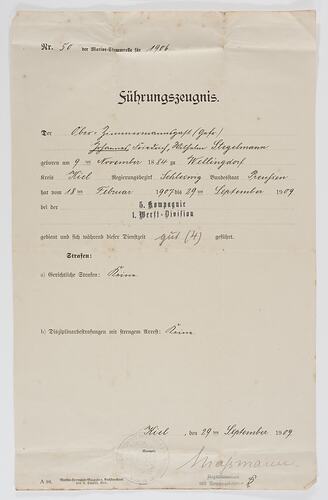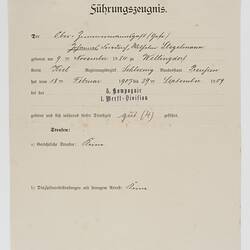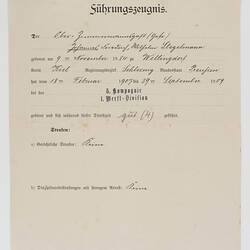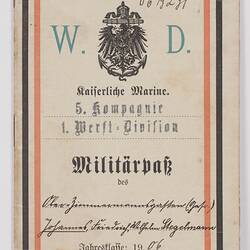Summary
Certificate of good conduct issued to J. Stegelman by the Royal German Navy. It is for the period from 18 February 1907 to 29 September 1909. German born Johannes (Jack) Stegelman completed a shipwright's apprenticeship in 1904 and became a carpenter on merchant vessels. Between 1907 and 1909 he spent time in the German Navy but then went back to working as a carpenter on merchant vessels. In 1911 he worked with the German Australian Steamship Company and when he was docked in Australia he, along with two others, jumped ship as he wanted to avoid being conscripted into the German navy again.
Description of Content
Certificate of good conduct Issued by German Navy Personnel to J. Stegelmann for period 18/2/1907 to 29/9/1909.
Physical Description
Yellowing paper with black printed text. Personal details written in pen. Some purple stamps. All in German.
Significance
Johannes Stegelman's story is a great example of more unorthodox migration. Jumping ship was a common way to start a new life in Australia, especially for sailors on merchant ships, and dates back to the 1850s gold rush with sailors jumping ship to head for the goldfields (John Simpson Kirkpatrick of 'Simpson and his donkey' fame arrived in Australia by jumping ship). Stegelman's objects all relate to his career in both the German Navy and the merchant navy including the hire document that brought him to Australia. The story is also interesting for its cross-cultural marriage and the bringing together of two very different migrant stories from different periods in time.
Gladys Leichti's objects and story represents the push to attract young British girls for domestic service in the 1920s and the role of philanthropic organizations such as the Salvation Army in meeting this demand.
More Information
-
Collecting Areas
Migration & Cultural Diversity, Public Life & Institutions, Transport
-
Acquisition Information
Donation from Margaret Steglman, 29 Nov 2006
-
Issued To
-
Place & Date Issued
Germany, 18 Feb 1907 - 29 Sep 1909
Period of service in the Royal German Navy -
Inscriptions
Text: Fuhrungszeugnis.
-
Classification
-
Category
-
Discipline
-
Type of item
-
Overall Dimensions
34 cm (Length), 21.6 cm (Width)
-
Keywords
Apprenticeships, German Communities, German Immigration, Immigration, Merchant Seamen, Shipboard Travel, Shipping Companies, Shipping Industry, Trades, Tradespeople



